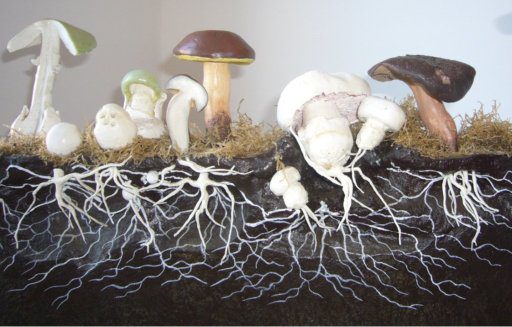In the fungal life cycle, mushrooms are only really the tip of the iceberg.
This is because when we refer to a mushroom, what we are actually talking about is the final phase in the life cycle of a fungus. Mushrooms, or ‘fruiting bodies,’ usually occur for just a few days. The majority of the fungal life cycle takes place hidden underground.
As a cultivator of mushrooms, it is critical to understand this life cycle. What we really aim to cultivate and nurture is fungal mycelium. If you can learn to do that effectively, then rest assured you will grow plenty of mushrooms.

Spores
Fungal spores are very similar to the seeds of a plant. They contain all the genetic material required to propagate the next generation of a fungus. A single mushroom cap can release billions of spores, which are dispersed via wind into the surrounding environment.
If a single spore is lucky enough to find itself in a nutrient rich environment, i.e., its substrate (food), and the conditions are just right, it will germinate. Cultivators call this the inoculation stage.
Spore Germination
Once a spore germinates, cellular replication occurs, leading to the formation of thread like fungal filaments called hyphae. These filamentous hyphae branch out in search of a compatible mate. If successful in doing so, the hyphae mate, fusing together to form fertile mycelium. The mycelium is known as dikaryotic (having two sets of nuclei).
Mycelium
The fungal mycelium then grows at an exponential rate, expanding the size of the mycelial network rapidly. Mycelium releases enzymes that decompose organic materials to their constituent nutrient compounds, which it can then absorb to fuel further growth and expansion. Cultivators call this the colonisation stage.
After a period of several weeks, the mycelium starts to condense into dense, hyphal knots. Hyphal knots then develop into primordia. Cultivators refer to primordia as ‘pins,’ aka baby mushrooms.
Fruiting Body
As thousands of these primordia form, fruiting body selection takes place. This is where only a few of the healthiest, most vigorous pins are selected to develop into mature fruiting bodies, i.e., mushrooms. Cultivators call this the fruiting stage.
As the fungus comes to the end of its life cycle, it dedicates all of its energy and nutrients to the development of fruiting bodies. Mature fruiting bodies generate spores, which are released and dispersed into the surrounding environment. Spore release signals the final act of the life cycle, propagating the next generation of fungi.
The fungal life cycle is a testament to the remarkable diversity and ingenuity of nature.

